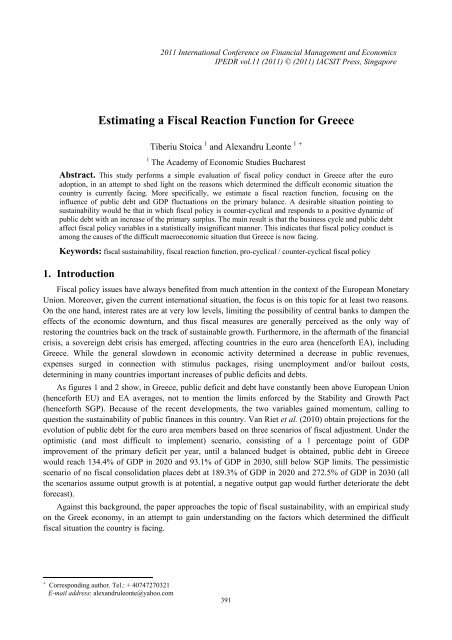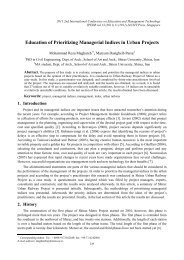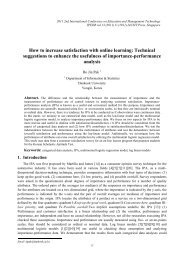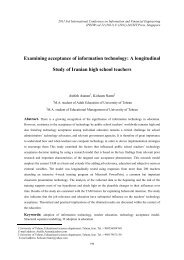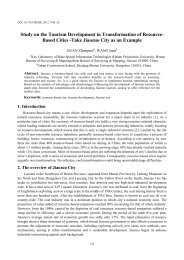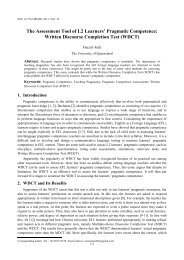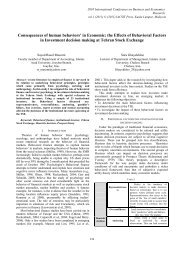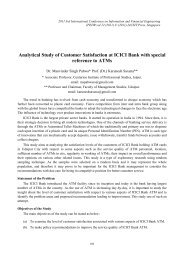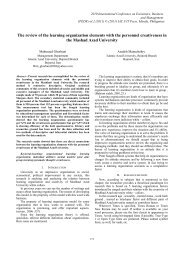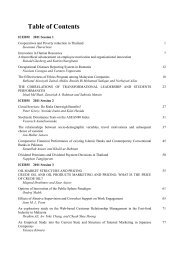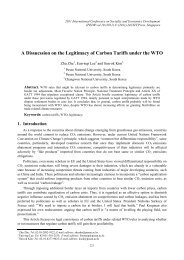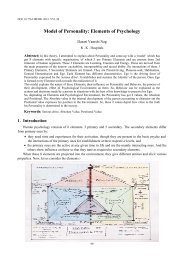Estimating a Fiscal Reaction Function for Greece - ipedr
Estimating a Fiscal Reaction Function for Greece - ipedr
Estimating a Fiscal Reaction Function for Greece - ipedr
Create successful ePaper yourself
Turn your PDF publications into a flip-book with our unique Google optimized e-Paper software.
2011 International Conference on Financial Management and Economics<br />
IPEDR vol.11 (2011) © (2011) IACSIT Press, Singapore<br />
<strong>Estimating</strong> a <strong>Fiscal</strong> <strong>Reaction</strong> <strong>Function</strong> <strong>for</strong> <strong>Greece</strong><br />
Tiberiu Stoica 1 and Alexandru Leonte 1 +<br />
1 The Academy of Economic Studies Bucharest<br />
Abstract. This study per<strong>for</strong>ms a simple evaluation of fiscal policy conduct in <strong>Greece</strong> after the euro<br />
adoption, in an attempt to shed light on the reasons which determined the difficult economic situation the<br />
country is currently facing. More specifically, we estimate a fiscal reaction function, focusing on the<br />
influence of public debt and GDP fluctuations on the primary balance. A desirable situation pointing to<br />
sustainability would be that in which fiscal policy is counter-cyclical and responds to a positive dynamic of<br />
public debt with an increase of the primary surplus. The main result is that the business cycle and public debt<br />
affect fiscal policy variables in a statistically insignificant manner. This indicates that fiscal policy conduct is<br />
among the causes of the difficult macroeconomic situation that <strong>Greece</strong> is now facing.<br />
Keywords: fiscal sustainability, fiscal reaction function, pro-cyclical / counter-cyclical fiscal policy<br />
1. Introduction<br />
<strong>Fiscal</strong> policy issues have always benefited from much attention in the context of the European Monetary<br />
Union. Moreover, given the current international situation, the focus is on this topic <strong>for</strong> at least two reasons.<br />
On the one hand, interest rates are at very low levels, limiting the possibility of central banks to dampen the<br />
effects of the economic downturn, and thus fiscal measures are generally perceived as the only way of<br />
restoring the countries back on the track of sustainable growth. Furthermore, in the aftermath of the financial<br />
crisis, a sovereign debt crisis has emerged, affecting countries in the euro area (hence<strong>for</strong>th EA), including<br />
<strong>Greece</strong>. While the general slowdown in economic activity determined a decrease in public revenues,<br />
expenses surged in connection with stimulus packages, rising unemployment and/or bailout costs,<br />
determining in many countries important increases of public deficits and debts.<br />
As figures 1 and 2 show, in <strong>Greece</strong>, public deficit and debt have constantly been above European Union<br />
(hence<strong>for</strong>th EU) and EA averages, not to mention the limits en<strong>for</strong>ced by the Stability and Growth Pact<br />
(hence<strong>for</strong>th SGP). Because of the recent developments, the two variables gained momentum, calling to<br />
question the sustainability of public finances in this country. Van Riet et al. (2010) obtain projections <strong>for</strong> the<br />
evolution of public debt <strong>for</strong> the euro area members based on three scenarios of fiscal adjustment. Under the<br />
optimistic (and most difficult to implement) scenario, consisting of a 1 percentage point of GDP<br />
improvement of the primary deficit per year, until a balanced budget is obtained, public debt in <strong>Greece</strong><br />
would reach 134.4% of GDP in 2020 and 93.1% of GDP in 2030, still below SGP limits. The pessimistic<br />
scenario of no fiscal consolidation places debt at 189.3% of GDP in 2020 and 272.5% of GDP in 2030 (all<br />
the scenarios assume output growth is at potential, a negative output gap would further deteriorate the debt<br />
<strong>for</strong>ecast).<br />
Against this background, the paper approaches the topic of fiscal sustainability, with an empirical study<br />
on the Greek economy, in an attempt to gain understanding on the factors which determined the difficult<br />
fiscal situation the country is facing.<br />
+ Corresponding author. Tel.: + 40747270321<br />
E-mail address: alexandruleonte@yahoo.com<br />
391
Fig. 1: Government consolidated gross debt (% of GDP), source: IMF World Economic Outlook Database.<br />
Fig. 2: Government deficit (% of GDP), source: IMF World Economic Outlook Database.<br />
Numerous approaches have been developed in order to study fiscal sustainability, the interested reader<br />
can consult Chalk and Hemming (2000) or Giammarioli et al. (2007) <strong>for</strong> discussions and reviews. A popular<br />
method to assess the strength of public finances is to check if the government is in compliance with the<br />
Present Value Borrowing Constraint (hence<strong>for</strong>th PVBC, which is also known as the Intertemporal <strong>Fiscal</strong><br />
Constraint). According to the PVBC, the current value of government debt is less than or equals the sum of<br />
discounted future government surpluses, implying that the government is not financing its activities through<br />
a Ponzi scheme. Earlier papers like Hamilton and Flavin (1986), Hakkio and Rush (1991), Quintos (1995),<br />
which study the US economy, along with more recent papers which study other economies (<strong>for</strong> a review see<br />
Afonso (2005)) employ the PVBC methodology, empirically testing the constraint by determining the order<br />
of integration of the public debt series, or by checking to see if there is a cointegration relationship between<br />
government revenues and expenditures. However, other papers adopt a critical point of view regarding this<br />
methodology. Bohn (2007) argues in favour of an approach that relies more on economic intuition, and gives<br />
several examples of studies which follow a fiscal reaction function approach.<br />
We follow the recommendation in the a<strong>for</strong>ementioned paper, specifically, we build and estimate a fiscal<br />
reaction function <strong>for</strong> the Greek economy. A significant number of studies employ this methodology.<br />
Building on the work of Barro (1979, 1986), Bohn (1998) uses a multiple regression to assess the systematic<br />
relationship between the primary surplus (the dependent variable) and public debt (one of the explanatory<br />
variables, along with temporary government spending and a measure of the business cycle) in the US<br />
economy. He finds that authorities have responded to a positive dynamic of debt with an increase of the<br />
primary deficit, which points to a sustainable fiscal position. A similar approach is put <strong>for</strong>ward in papers<br />
which focus on EA and EU members. Gali and Perotti (2003) emphasize that in order to capture the<br />
influence of discretionary policy measures, cyclically adjusted fiscal variables must be included in the<br />
reaction function. Their baseline specification includes the primary deficit (cyclically adjusted) as dependent<br />
variable and the current output gap, last period’s debt and the dependent variable with one lag as explanatory<br />
variables, and they further develop the model by including dummy variables associated with the Maastricht<br />
Treaty and the SGP in order to observe the influence of these events on the relationship between fiscal policy<br />
and the business cycle. The sample includes observations that cover the period 1980-2002, <strong>for</strong> the EA12<br />
countries except Luxembourg, and two control groups. In all the analyzed countries except the Netherlands,<br />
392
the debt coefficient is negative (pointing to sustainability), however in most cases statistically insignificant,<br />
including the case of <strong>Greece</strong>. Ballabriga and Martinez-Mongay (2005) argue it would be more appropriate to<br />
use the previous period’s output gap as an explanatory variable, due to the lags in implementing fiscal policy<br />
decisions. According to their results, in <strong>Greece</strong>, an increase in public debt is followed by an increase of the<br />
primary surplus the following period, the debt coefficient being positive and statistically significant across<br />
specifications. Models with a larger number of explanatory variables require more degrees of freedom to<br />
obtain significant results, and are generally estimated using panel data. Examples of papers following this<br />
approach are Afonso and Hauptmeier (2009) who study the influence of government spending<br />
decentralization on fiscal policy, or Tagkalakis (2010), who focuses on the connection between fiscal<br />
variables and asset prices.<br />
2. The model<br />
In this paper we estimate a fiscal reaction function <strong>for</strong> the Greek economy. With regard to the dependent<br />
variable of the multiple regression, we followed Tagkalakis (2010) and opted <strong>for</strong> the unadjusted primary<br />
deficit. Our choice is motivated by the numerous shortfalls in the methodology of determining cyclically<br />
adjusted variables, see Girouard and André (2005), box 1, <strong>for</strong> a discussion. Moreover, we shall attempt to<br />
distinguish between the influence of automatic stabilizers and discretionary policy measures by estimating a<br />
reaction function in which the dependent variable will be public spending. As Fedelino et al. (2009) notice,<br />
public spending is not correlated with the business cycle, with the exception of unemployment-related<br />
expenses, which generally hold a small weight in total public expenses, there<strong>for</strong>e, the dynamic of public<br />
expenses generally reflects discretionary decisions.<br />
Our baseline model is represented by the following multiple regression:<br />
pr _ balt<br />
= α<br />
1<br />
+ β1<br />
⋅ pr _ balt− 1<br />
+ γ<br />
1<br />
⋅ y _ gapt−<br />
1<br />
+ δ1<br />
⋅ debtt−<br />
1<br />
+ ε<br />
t<br />
(1)<br />
where pr_bal is the primary balance (surplus), expressed as percentage deviation of actual GDP from<br />
potential GDP, y_gap is the output gap, expressed as ratio to potential GDP, and debt is government debt,<br />
expressed as percentage deviation from the value in the previous period.<br />
Since our goal is to shed light on the fiscal policy variables in the post-euro adoption period, and gain<br />
understanding on the causes which determined the difficult fiscal situation the country is facing, we estimate<br />
equation (1) using quarterly data covering the period 2001Q1-2008Q2, because 2008Q3 was the first quarter<br />
of recession in <strong>Greece</strong>. Nominal debt is expressed in real terms using the Consumer Price Index. The output<br />
gap was determined as the percentage difference between actual GDP and potential GDP, the latter being<br />
proxied as the trend obtained with the Hodrick-Prescott filter. All data come from the Eurostat.<br />
Be<strong>for</strong>e estimating the model given by (1), we test the stationarity of the variables included in regression<br />
(1) using the Augumented Dickey Fuller (ADF) test. Results, which are reported in table 1, point to<br />
stationary series, we can there<strong>for</strong>e continue with the estimation procedure. Results are shown in table 2<br />
Table 1: ADF test results <strong>for</strong> the variables in equation (1)<br />
Series Test statistic Conclusion<br />
Primary balance -2.7477* Series is stationary<br />
Debt -5.6019*** Series is stationary<br />
Output gap -5.2124*** Series is stationary<br />
Note: * and *** stand <strong>for</strong> statistical significance at the 90% and 99% levels, respectively.<br />
Source: Author’s calculations in Eviews..<br />
Table 2: Estimation results <strong>for</strong> equation (1)<br />
Coefficient β<br />
1<br />
(balance (t-1)) γ<br />
1<br />
(output gap(t-1)) δ<br />
1<br />
(debt % variation (t-1))<br />
Estimation 0.5717*** -0.3732 0.1631<br />
Source: Author’s calculations in Eviews.<br />
393
We can see that the most significant influence on the primary balance is given by the value of the same<br />
variable in the previous period, there<strong>for</strong>e we can state that there is a significant degree of inertia in fiscal<br />
policy. The coefficient of the output gap is negative, pointing to a pro-cyclical policy, however the<br />
estimation is statistically insignificant. Our main focus is on the coefficient of lagged debt, and we find that<br />
is positive, thus indicating sustainability, but insignificant.<br />
Using the cyclically unadjusted primary balance is equation (1) renders us unable to separate the<br />
influence of automatic stabilizers from that of discretionary measures in the reaction of the fiscal policy<br />
variable to business cycle and public debt developments. Given that primary government spending is largely<br />
unaffected by the business cycle, we can use this variable to replace the primary deficit in equation (1), and<br />
interpret the parameters as discretionary reactions. There<strong>for</strong>e, we estimate the following model:<br />
pr _ ext<br />
= α<br />
2<br />
+ β<br />
2<br />
⋅ pr _ ext− 1<br />
+ γ<br />
2<br />
⋅ y _ gapt−<br />
1<br />
+ δ<br />
2<br />
⋅ debtt−<br />
1<br />
+ et<br />
(2)<br />
where pr_ex represents government primary expenditures, expressed as ratio to GDP. Estimation results<br />
are reported in table 3.<br />
Table 3: Estimation results <strong>for</strong> equation (2)<br />
Coefficient β<br />
2<br />
(expenses (t-1)) γ<br />
2<br />
(output gap(t-1)) δ<br />
2<br />
(debt % variation (t-1))<br />
Estimation 0.4370** 0.7375 -0.1671<br />
Note: * * stands <strong>for</strong> statistical significance at the 95% level.<br />
Source: Author’s calculations in Eviews.<br />
Results are in line with those of equation (1). Inertia seems to be the main characteristic of fiscal policy<br />
conduct in <strong>Greece</strong>. An increase in public expenses will trigger on average an increase of the variable in the<br />
following period also, which indicates an unsustainable path of public expenses. With regard to the output<br />
gap, the authorities’ reaction is pro-cyclical, however statistically insignificant. An increase in debt will<br />
determine on average a decrease in primary expenses, pointing to fiscal sustainability, still the estimation is<br />
insignificant, and so we cannot draw a firm conclusion.<br />
3. Conclusions<br />
In this paper we estimated a fiscal reaction function <strong>for</strong> the Greek economy, focusing on the period<br />
which started with the euro adoption and ended when the economic recession began. Our objective was to<br />
gain understanding on whether fiscal policy conduct is one of the causes which determined the difficult<br />
economic situation that <strong>Greece</strong> is now facing. We found that fiscal policy is mainly driven by inertia, while<br />
the business cycle and public debt affect fiscal variables in a statistically insignificant manner. This indicates<br />
that fiscal policy conduct is indeed among the causes of the Greek economic turmoil.<br />
4. Acknowledgements<br />
This is a result of the project POSDRU/6/1.5/S/11 “Doctoral Program and PhD Students in the education<br />
research and innovation triangle”. This project is co founded by the European Social Fund through The<br />
Sectorial Operational Programme <strong>for</strong> Human Resources Development 2007-2013, coordinated by The<br />
Bucharest Academy of Economic Studies.<br />
5. References<br />
[1] A. Afonso. <strong>Fiscal</strong> sustainability: the unpleasant European Case. FinanzArchiv. 2005, 61(1): 19-44<br />
[2] A. Afonso and S. Hauptmeier. <strong>Fiscal</strong> behaviour in the European Union: rules, fiscal decentralization and<br />
government indebtness. European Central Bank Working Paper no. 1054. 2009<br />
[3] F. Ballabriga and C. Martinez-Mongay. Sustainability of EU public finances. European Comission Economic<br />
Papers no. 225<br />
[4] R. Barro. On the Determination of the Public Debt. Journal of Political Economy. 1979, 87(5): 940-971<br />
[5] R. Barro. U. S. Deficits Since World War I. The Scandinavian Journal of Economics. 88(1): 195-222.<br />
[6] H. Bohn. The Behaviour of U. S. Public Debt and Deficits. The Quarterly Journal of Economics. 1998, 113(3):<br />
394
949-963<br />
[7] H. Bohn. Are stationarity and cointegration restrictions really necessary <strong>for</strong> the intertemporal budget constraint?.<br />
Journal of Monetary Economics. 2007, 54: 1837-1847<br />
[8] N. Chalk and R. Hemming. Assessing fiscal sustainability in theory and practice. IMF Working Paper no. 81,<br />
2000.<br />
[9] A. Fedelino, A. Ivanova and M. Horton. Computing Cyclically Adjusted Balances and Automatic Stabilizers. IMF<br />
Technical Notes and Manuals. 2009.<br />
[10] J. Galí and R. Perotti. <strong>Fiscal</strong> Policy and Monetary Integration in Europe. NBER Working Paper no. 9773. 2003<br />
[11] N. Giammarioli, C. Nickel, P. Rother and J. P. Vidal. Assessing fiscal soundness. Theory and practice. European<br />
Central Bank Occasional Paper no. 56. 2007<br />
[12] N. Girouard and C. André. Measuring Cyclically-adjusted budget balances <strong>for</strong> OECD countries. OECD<br />
Economics Department Working Paper no. 434. 2005<br />
[13] C. Hakkio and M. Rush. Is the Budget Deficit ‘Too Large’?. Economic Inquiry. 1991, 29(3): 429-446.<br />
[14] J. Hamilton and M. Flavin. On the limitations of government borrowing: a framework <strong>for</strong> empirical testing.<br />
American Economic Review. 1986, 76: 808-819<br />
[15] C. Quintos. Sustainability of the Deficit Process With Structural Shifts. Journal of Business & Economic Statistics.<br />
1995, 13(4): 409-417<br />
[16] A. Tagkalakis. <strong>Fiscal</strong> policy and financial market movements. Bank of <strong>Greece</strong> Working Paper no. 116. 2010<br />
[17] A. van Riet (editor). Euro area fiscal policies and the crisis. European Central Bank Occasional Paper no. 109.<br />
2010<br />
395


